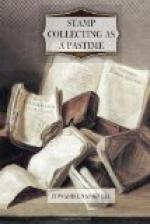What is known as the V.R. Penny black, English stamp, is said to have been designed as an experiment in providing a special stamp for official use, its official character being denoted by the initials V.R. in the upper corners; but the proposal was dropped, and the V.R. Penny black was never issued. For a long time it was treasured up as a rarity by collectors, but now that its real claims to be regarded as an issued stamp have been finally settled, it is no longer included in our stamp catalogues. In the days of its popularity it fetched as much as L14 at auction. It is now relegated to the rank of an interesting souvenir of the experimental stage in the introduction of Penny Postage.
Of curious blunders, the Cape of Good Hope errors of colours are amongst the most notable. In 1861 the 1d. and 4d. triangular stamps, then current, were suddenly exhausted, and before a stock could be obtained from the printers in England, a temporary supply had to be provided locally. This was done by engraving imitations of the originals. Stereos were then taken, and made up into plates for printing. By an oversight a stereo of the penny value was dropped into the fourpenny plate and a fourpenny into the penny plate. Consequently, each sheet printed in the required red ink from the penny plate yielded a fourpenny wrongly printed in red instead of blue, its proper colour; and every sheet of the fourpenny likewise yielded a penny stamp printed in blue instead of red. These errors are highly prized by collectors, and are now extremely scarce, even poor specimens fetching from L50 to L60. At the time, copies were sold by dealers for a few shillings each. Similar errors are known in the stamps of other countries.
Now and again the sheets of a particular value have, by some extraordinary oversight, been printed and issued in the wrong colour. In 1869 copies of the 1s. of Western Australia were printed in bistre instead of in green, and a few years later the twopence was discovered in lilac instead of yellow. In 1863 a supply of shilling stamps was sent out to Barbados printed in blue instead of black; but this latter error was, according to Messrs. Hardy and Bacon, so promptly discovered, that it is doubtful if any of the wrong colour were issued for postal use. In 1896 the fastidiously careful firm of De la Rue and Co. printed off and despatched to Tobago a supply of 6,000 one shilling stamps in the colour of the sixpenny, i.e. in orange-brown instead of olive-yellow. Several are said to have been issued to the public before the error had been noticed. Indeed, the firm at home is credited with having first discovered the mistake, and is said to have telegraphed to the colony in time to prevent their issue in any quantity.
Another and much more common error in the early days of stamp production was the careless placing of one stamp on a plate upside down. Stamps so placed are termed tete-beche. They have to be collected in pairs to show the error. The early stamps of France furnish many examples of this class of error. They are also to be found on the 6d. and 1s. values of the first design of the stamps of the Transvaal, on the early issues of Roumania, on some of the stamps of the Colombian Republic, and other countries.




